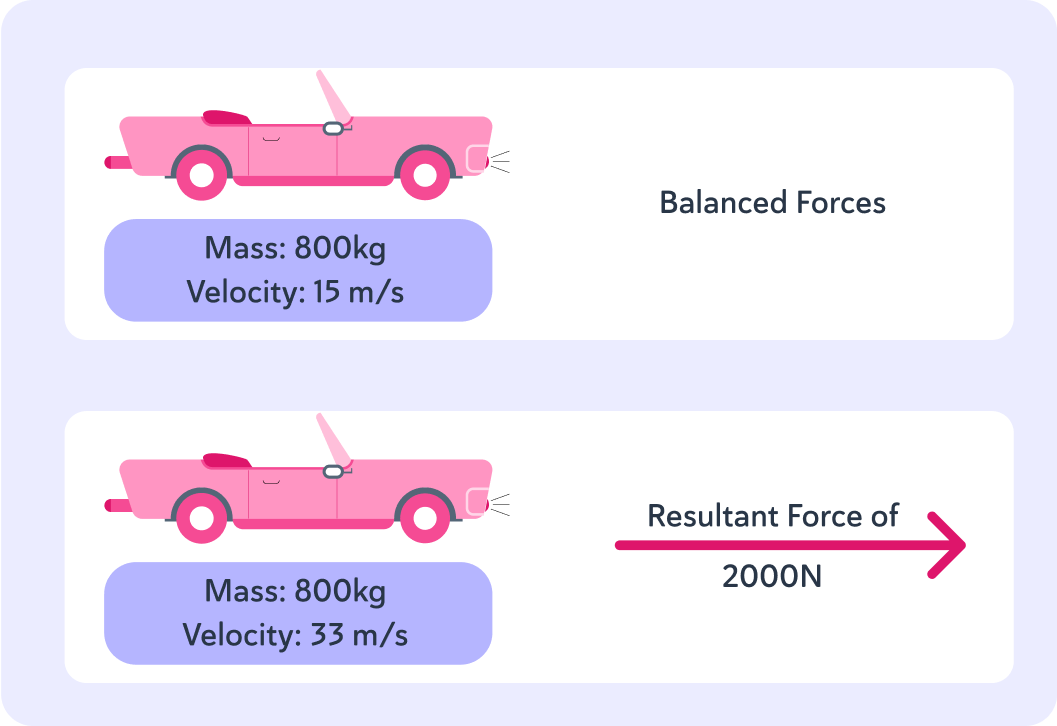YOU ARE LEARNING:
Changes in Momentum

Changes in Momentum
We can introduce a force into an object that is moving, which will change its momentum.
When a car is travelling at a steady speed, all of the forces acting on it are balanced. If an unbalanced force in the forwards direction was to act upon the car, the car would...

If the resultant force acting on the car is 10,000 N, and the mass of the car is 800 kg, what is its acceleration?

According to Newton's second law, acceleration is proportional to the resultant force acting on an object. The formula force=mass×acceleration can be rearranged to Acceleration=massforce. This formula can be used to help us understand changes in momentum.
If a car accelerates forwards because of an unbalanced force acting on it, its momentum will...

Momentum is mass multiplied by velocity p=mv, so if the velocity of an object changes then its momentum must also change.
So if an unbalanced force causes a change of velocity, this means that a force acting on a moving object (which is able to move), causes a change of momentum.
When the car is moving at a steady speed, how much momentum does it have? Make sure you include the correct unit for momentum in your answer.


The driver pushes the pedal causing a resultant force to act on the car. What is its acceleration?


After the acceleration, the car has more velocity. What is its momentum now?


This shows us that Newton's Second Law and changes in momentum are interlinked!
The resultant force acting on the car caused both a change of velocity and a change of momentum.

There is another formula we can use to find the acceleration of an object when you do not know the magnitude of the force acting on it, or its mass. Can you remember the formula?

A runner with a mass of 65 kilograms accelerates and changes his velocity by 2 metres per second. His change of momentum is Δ 130 kg m/s. How do you think mass, change of velocity, and change of momentum are related?

We know that the magnitude of momentum of an object is dependent on its mass and velocity, so it makes sense that mass×change of velocity=change of momentum. This formula is sometimes written as m×Δv=Δp, where the delta symbol just means "change of".
If a car with a mass of 900 kilograms, accelerates from zero to 15 metres per second, how much momentum has it gained?

A cyclist and his bike have a combined mass of 150 kilograms. The cyclist accelerates from 3 to 10 metres per second, how much momentum have the cyclist and his bike gained?

A cyclist accelerates from 3 to 10 metres per second in 15 seconds, and his momentum increases by1050 kg m/s. His rate of change of momentum is 70 kg m/s2. How do we find the rate of change of momentum?

We know that Newton's Second Law tells us that Force=mass×acceleration, and that acceleration=timechange of velocity. We also know that mass×change of velocity=change of momentum. There is one final formula linking momentum and force that you need to know!
How are force and rate of change of momentum related?
The three formulae you have used this lesson are interlinked and can be combined. F=ma and a=timeΔv, so how could you combine these two formulae?

Force is equal to mass multiplied by the change of velocity over time.
We can see this is true because we can combine F=ma and a=timeΔvto make F=timem×Δv.
F=timem×Δv and m×Δv=Δp, so how are force and rate of change of momentum related?

The rate of change of momentum is equal to the force acting on an object
We can see that this is true because you can replace m×Δv with Δp in the first formula which gives you this formula F=timeΔp
